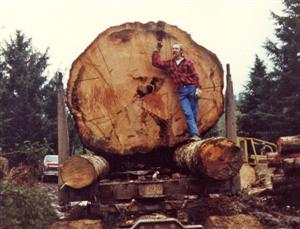COVER FEATURE - APRIL 2008
LOGGING LARGE
MIKE BROWN HAULS LOGS WITH STYLE
By Daniel J. Linss - Editor
Mike Brown (54) of Philomath, Oregon, does not like change. He has lived on the same ranch in Oregon for his entire life; he has driven a log truck since he was old enough to reach the pedals; he has been married to his wife for 35 years; and after spending five years rebuilding the 1952 Peterbilt Model 350 pictured here and on our cover/centerfold this month, he drove it every day for fourteen years. And aside from a few minor “adjustments” to his current operation, the only thing that has (and will) change is the truck Mike is now driving.
Just one week after our photo shoot with Mike, he sold the truck to a friend and fellow trucker named Don Taylor of Sheridan, Oregon. Don is already out running loads of logs with the truck. This story is a sort of tribute to the old Peterbilt, and all the memories Mike made in it – not only rebuilding it, but driving it, too. This truck is no museum piece – it’s a work truck – and Mike worked it hard, in harsh conditions, every day for fourteen years. He did not “restore” this old truck, so purists beware – it is a compilation of a few trucks, built on a newer chassis, with plenty of customization. But it still looks like a cool old truck!
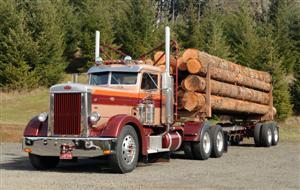 Mike was born and raised in Philomath and still lives there today. Back in the day, Philomath was a booming log town, complete with several sawmills, sort yards and processing plants (they even had their own post office). Today, most of that is gone – Philomath’s prosperity fell victim to closures, buyouts and environmentalists. Mike’s dad Pat was a small contract logger who usually worked for private land owners. In his heyday, Pat Brown had about five trucks.
Mike was born and raised in Philomath and still lives there today. Back in the day, Philomath was a booming log town, complete with several sawmills, sort yards and processing plants (they even had their own post office). Today, most of that is gone – Philomath’s prosperity fell victim to closures, buyouts and environmentalists. Mike’s dad Pat was a small contract logger who usually worked for private land owners. In his heyday, Pat Brown had about five trucks.
Mike learned to drive in his dad’s 3-stick B-Model Mack. Driving off-road and on job sites, Mike learned the ropes pretty quick. Anytime he could get away from school, he was either with his dad in his truck or driving one himself. He hauled his first load of logs on the highway, by himself, at the age of fourteen. Many have said that once diesel gets in your veins, all you can do about it is go trucking. Mike says the addiction potential to log trucking is even worse.
Mike and his father shared a love for log trucking and both enjoyed the freedom that came with operating a self-loader. A self-loader is a piece of machinery that is mounted to the frame behind the cab which allows the logger to load his own truck. No crew – no big machines – just Mike and his truck out in the forest, making his own schedule. For years, Mike had a self-loader mounted on this old truck, but he had recently removed it when preparing to sell the Pete.
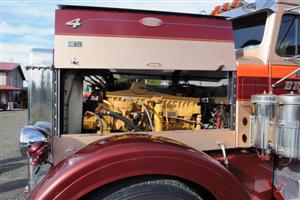 Logging has always been one of the most dangerous jobs, but over the years, technology has made it much safer. Today, logging is done with sophisticated heavy equipment. Most timber is no longer touched by human hands. Huge harvesters equipped with a “hot saw” drive right up to a full-sized tree and buzz it down in a matter of seconds. Large hooks above the saw hold the tree while it is being cut. Once it is completely severed, the operator lays the felled tree wherever he wants it. Hand saws are no longer necessary. But log trucking is still pretty dangerous. Most of the time, log truckers drive on steep dirt roads with sharp switchbacks (or on no road at all) in some of the worst weather conditions – all the while carrying a big, bulky load of logs that would rather not be on the back of a truck and frequently attempt to escape. Although he is a great driver with a good record, Mike has a few interesting stories involving rolled over and “bent up” log trucks.
Logging has always been one of the most dangerous jobs, but over the years, technology has made it much safer. Today, logging is done with sophisticated heavy equipment. Most timber is no longer touched by human hands. Huge harvesters equipped with a “hot saw” drive right up to a full-sized tree and buzz it down in a matter of seconds. Large hooks above the saw hold the tree while it is being cut. Once it is completely severed, the operator lays the felled tree wherever he wants it. Hand saws are no longer necessary. But log trucking is still pretty dangerous. Most of the time, log truckers drive on steep dirt roads with sharp switchbacks (or on no road at all) in some of the worst weather conditions – all the while carrying a big, bulky load of logs that would rather not be on the back of a truck and frequently attempt to escape. Although he is a great driver with a good record, Mike has a few interesting stories involving rolled over and “bent up” log trucks.
Mike’s trucks have always been numbered in the order they were purchased. His first truck (#1), was an old narrow-nose Pete he bought in 1978. He drove that truck for a year and then purchased a new 1979 Peterbilt painted blue (#2). Truck #3 was an old 1952 GMC Mike bought to restore, but it sat in his yard, untouched, for years until he sold it to a collector that spotted it out in his yard. This brings us up to truck #4 – the 1952 Peterbilt. In 1982 Mike found the truck out in a field, where it had been sitting, along with seven other trucks, since the construction of Interstate 5 had been completed – and it was in bad shape. After dragging the two-axle truck home, he parked it in his yard, where it sat for a few more years.
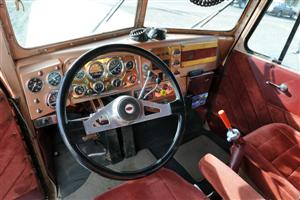 In 1986, Mike bought a complete 3-axle 1977 log truck that had a blown engine with the intention of using it as a “base” for his 1952. But a few more years passed before that project actually began. In the meantime, Mike was still working and still buying trucks (today he is up to #29). A few years prior, in 1983, he ordered his first custom spec’d new truck from Peterbilt with a three-tone metallic color scheme (Santa Fe Pearl with Metallic Maroon and Bright Orange), which you now see on the 1952 Peterbilt. All of his trucks since then have featured this exact color scheme, except for his latest truck, which is all orange. Had he known that he would be buying this many trucks over his lifetime and that the price of metallic paint would skyrocket, he never would have opted for such an expensive paint scheme. So, when it finally came time for Mike to begin the rebuilding process, he knew what colors to use on old #4.
In 1986, Mike bought a complete 3-axle 1977 log truck that had a blown engine with the intention of using it as a “base” for his 1952. But a few more years passed before that project actually began. In the meantime, Mike was still working and still buying trucks (today he is up to #29). A few years prior, in 1983, he ordered his first custom spec’d new truck from Peterbilt with a three-tone metallic color scheme (Santa Fe Pearl with Metallic Maroon and Bright Orange), which you now see on the 1952 Peterbilt. All of his trucks since then have featured this exact color scheme, except for his latest truck, which is all orange. Had he known that he would be buying this many trucks over his lifetime and that the price of metallic paint would skyrocket, he never would have opted for such an expensive paint scheme. So, when it finally came time for Mike to begin the rebuilding process, he knew what colors to use on old #4.
The rebuild began in 1989 and was not completed until 1994, with the first year and the last seeing most of the work. To begin, the aluminum “donor” chassis from the 1977 log truck was stripped to the frame, sandblasted, and painted. A rebuilt Cat 3406C engine was installed and then the 40,000-lb. Eaton 2-speed rear ends, 4RTO12513 transmission and brakes were completely rebuilt. Mike replaced the 52’s rusted steel cab with an aluminum cab from another truck but kept the original steel doors. The front fenders are from a 1946 Pete. Mike spent over five weeks customizing these fenders by cutting three inches off the front and adding seven inches to the back so he could mount them lower and more forward so that everything would line up nice and tight, like all his newer trucks. The butterfly hood was rebuilt with extra thick aluminum and is tough as nails (you can stand on it). The shutters were also completely rebuilt and actually worked for a while until the cable got a kink in it. Now, they just stay open all the time which is good – the 400 horsepower motor requires a lot of air to keep it cool.
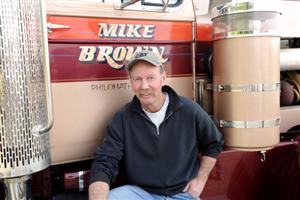 One really interesting accessory on this truck is the visor. Mike searched and searched but could not find a good (unbroken) original visor. He finally called someone at Peterbilt and explained his situation. That person made a copy of the original blueprint (dated 1954) and sent it to Mike, who took it to a sheet metal shop and had one made out of stainless steel. But those old visors were always prone to break, so Mike took the original design and improved upon it a bit. He still has that copy of the original blueprint from Peterbilt. This visor, as well as all of the other parts on the truck, has stood the test of time. Fourteen years and 330,000 miles later, the old Peterbilt pretty much looks the same as when he finished it – aside from a little “road rash” on the rear fenders. It just goes to show, if you do a job right, it will last.
One really interesting accessory on this truck is the visor. Mike searched and searched but could not find a good (unbroken) original visor. He finally called someone at Peterbilt and explained his situation. That person made a copy of the original blueprint (dated 1954) and sent it to Mike, who took it to a sheet metal shop and had one made out of stainless steel. But those old visors were always prone to break, so Mike took the original design and improved upon it a bit. He still has that copy of the original blueprint from Peterbilt. This visor, as well as all of the other parts on the truck, has stood the test of time. Fourteen years and 330,000 miles later, the old Peterbilt pretty much looks the same as when he finished it – aside from a little “road rash” on the rear fenders. It just goes to show, if you do a job right, it will last.
Mike did most of the work himself, but he did get some help from a few folks that he wanted to mention. Mike got a lot of help from a great mechanic named Warren Eaton, and painters Boyd & Floyd Woodward did all of the pinstriping and gold leaf lettering. L & M Welding did some metal pressing and forming, while Swan Island Sheet Metal did some of the fabrication. Mike’s father Pat also helped out when he could on the project and, of course, Mike’s longtime wife Susan is always a big supporter of anything her husband does. Mike also wanted to thank Frank Miller, a well-known LT Mack truck collector, for originally inspiring Mike to build the ’52 (Frank had a photograph of one hanging on his wall). Mike saw it and loved it – the rest is history!
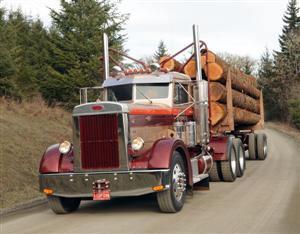 Today, Mike’s operation includes 13 trucks and nine drivers but he is beginning to scale back. Eventually, he wants to get back to the basics – just himself and one truck. Many of his drivers are planning to retire and some are going to buy the truck they are now driving and go at it alone, including one of Mike’s sons, Craig. Since selling the 1952 Peterbilt, Mike’s daily driver is truck #29 – an orange 1979 Pete 359 Extended Hood with a self-loader that he recently finished rebuilding. Looking forward to his next “big” project, Mike has already purchased a 1969 Peterbilt 359 Extended Hood.
Today, Mike’s operation includes 13 trucks and nine drivers but he is beginning to scale back. Eventually, he wants to get back to the basics – just himself and one truck. Many of his drivers are planning to retire and some are going to buy the truck they are now driving and go at it alone, including one of Mike’s sons, Craig. Since selling the 1952 Peterbilt, Mike’s daily driver is truck #29 – an orange 1979 Pete 359 Extended Hood with a self-loader that he recently finished rebuilding. Looking forward to his next “big” project, Mike has already purchased a 1969 Peterbilt 359 Extended Hood.
We’d like to thank Mike for allowing us to hang out with him all day and Bryan Welsh for being our dedicated, helpful Oregon tour guide. Hopefully, Don Taylor will take good care of old #4 so that it can continue to work for many more years to come. We can’t wait to see Mike’s next project when it is finished. With his meticulous attention to detail, we are sure it will be awesome! Mike might not like change, but some changes still need to happen from time to time. But one thing has never changed – Mike Brown knows how to haul logs with style and is still “Logging Large” after all these years.
